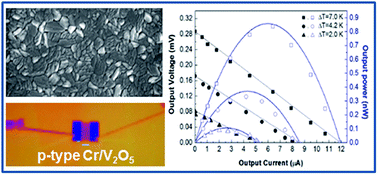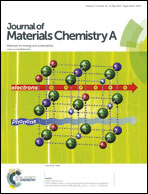Nanostructured p-type Cr/V2O5 thin films with boosted thermoelectric properties
Abstract
The urgent need for non-toxic and abundant thermoelectric materials has become a significant motivation to improve the figures of merit of metal oxides in order to remove the barrier towards their widespread use for thermoelectric applications. Here we show the influence of a Cr layer in boosting the thermoelectric properties of vanadium pentoxide (V2O5) thin films, deposited by thermal evaporation and annealed at 500 °C. The Cr to V2O5 thickness ratio controls the morphological and thermoelectric properties of the thin films produced. The optimized Seebeck coefficient and power factor values at room temperature are +50 μV K−1 and 7.9 × 10−4 W m−1 K−2, respectively. The nanograin structure of the films is responsible for an improvement in the electrical conductivity up to 3 × 105 (Ω m)−1 with a typical thermal conductivity of 1.5 W m−1 K−1. These results combine to yield promising p-type thermoeletric CrV2O5 thin films with a ZT of 0.16 at room temperature.


 Please wait while we load your content...
Please wait while we load your content...